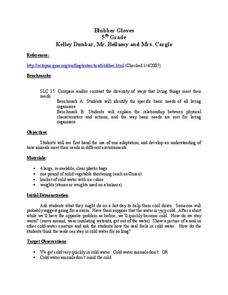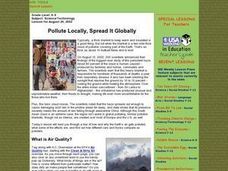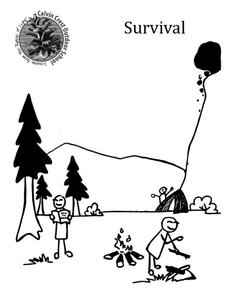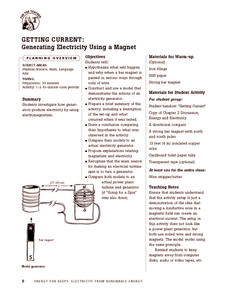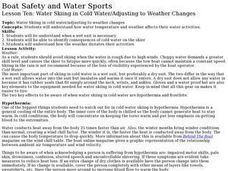Curated OER
Adobe
In this adobe worksheet, students read about adobe soil and how it was used for building because of its insulating properties. Students complete 3 short answer questions.
Curated OER
Insulation and Buoyancy
Pupils predict whether their hands be warmer in ice water with or without a blubber mitten. They construct a blubber mitten using plastic, Crisco and compare their results with a control group. They observe how this affects buoyancy too.
Curated OER
Animal Science - Body Temperature
Young scholars use the TI-83 + linked to the CBL2 and temperature probes to perform an experiment. Each of the temperature probes is placed into a different cup, one insulated and one not insulated. Each cup holds warm water. The two...
Curated OER
Fool-proof Yogurt
Students make yogurt from powdered milk. In this yogurt experiment lesson, students combine powdered milk, warm water and plain yogurt. They mix up the ingredients and put it in an insulated cooler for 6-8 hours.
Curated OER
Blubber Gloves
Fifth graders examine animal adaptations and how they meet their needs in a variety of environments. They discuss how they might adapt to their own environment before discussing how an animal could adapt. Next, they complete an...
Curated OER
Carbon Dioxide: The Heat is On
Students examine the greenhouse gases affecting the atmosphere. In groups, they participate in activities in which they examine the effects of heat on the atmosphere and phytoplankton. They research how the phytoplankton differ in warm...
Outdoor Learning Center
Outdoor Survival
Which of the following can you survive without for the longest time: water, food, or a positive mental attitude? The answer may surprise you. Guide learners of all ages through games, activities, and discussions about surviving in the...
Curated OER
Lost on Everest
What would it be like to be stranded on Mount Everest? Curious learners view a video clip, test common fabrics to see how they stand up to cold, and develop/answer discussion questions.
Curated OER
Pollute Locally, Spread It Globally
Students examine the rate of pollution throughout the world through an interactive program. They define air quality and the air quality index. They examine fuel economy and its impact on the Earth and renewable and nonrenewable resources.
Curated OER
Light - Plant Science Chapter #8
A brief presentation provides notes on light for agriculture pupils. Topics covered are light quality and duration, how resulting temperatures affect crop selection, vernilization, and bolting. Even though this is titled "Light," it...
Calvin Crest Outdoor School
Survival
Equip young campers with important survival knowledge with a set of engaging lessons. Teammates work together to complete three outdoor activities, which include building a shelter, starting a campfire, and finding directions in the...
Curated OER
Scientific Method Experiment: Factors Affecting How Ice Melts
Young scholars demonstrate the scientific method by conducting an ice cube melting experiment. They make predictions and observations, and conclude what factors make ice melt more slowly or quickly than normal.
American Museum of Natural History
Rubber Blubber Gloves
Using gloves, shortening, tape, and a lot of ice, participants experience the feeling of having blubber. The experiment's eight steps follow an informative page about blubber and animals that have it.
Curated OER
Fifth Grade Reading
In this reading worksheet, 5th graders complete multiple choice questions where they read 1 page stories and answer comprehension questions. Students complete 25 questions.
Curated OER
Blubber Mittens:Adaptation to Cold Climates
Students get a first hand look at the benefit of a "blubber layer" in cold climates through a simulation using vegetable shortening and icy water. Through this simulation, students examine how adaptations help organisms survive.
Curated OER
Electrical Principals and Wiring Materials
Train a budding electrician about the principles of electricity and the wiring materials needed to complete the job. Briefly covered are basic electrical concepts such as, volts, watts, circuits, and safety. Also covered are the...
Energy for Keeps
Getting Current: Generating Electricity Using a Magnet
Give your class a magnetic charge with this creative experiment designed to teach emerging scientists about electromagnetism. Pupils construct a model that demonstrates the function of an electrical generator and test this creation in a...
Curated OER
Outdoor Survival
Students are introduced to basic outdoor survival concepts. They identify the seven basic needs for survival. Students describe the symptoms and treatment for frostbite and hypothermia. They compare and contrast the value of different...
Curated OER
Just Get to the Good Part
Learners summarize nonfiction text. After reviewing the steps for summarization, students independently read a nonfiction article. They write a summary paragraph using the six-step process outlined by the instructor during guided practice.
Curated OER
Winter Survival
Students examine what animals need in order to survive. In this investigative lesson students play a "role" of an animal in winter.
Curated OER
Blubber Gloves
The ways that animals adapt to their environments is quite remarkable. In this life science lesson, fifth graders take a look at some of the ways that aquatic animals that live in Arctic or Antarctic waters survive. They perform an...
Curated OER
Boat Safety and Water Sports - Lesson 10 - Cold Water/Weather
Lesson 10 is part of a twenty-two lesson unit on boat safety and water sports. It focuses on how to handle cold water and cold weather when water skiing, as well as what to do if hypothermia or frostbite occur. Click on the resource...
Curated OER
Dolphin Dive
In this reading worksheet, students complete several paragraphs about dolphins by filling in the word that best completes the sentence. Thirteen words are included to complete the paragraphs.
Curated OER
Adaptations
Cacti have special adaptations for living in desert heat and dryness. Polar bears have adaptations that allow them to withstand icy conditions. Humans adapt to different conditions by wearing appropriate clothing or building homes...




